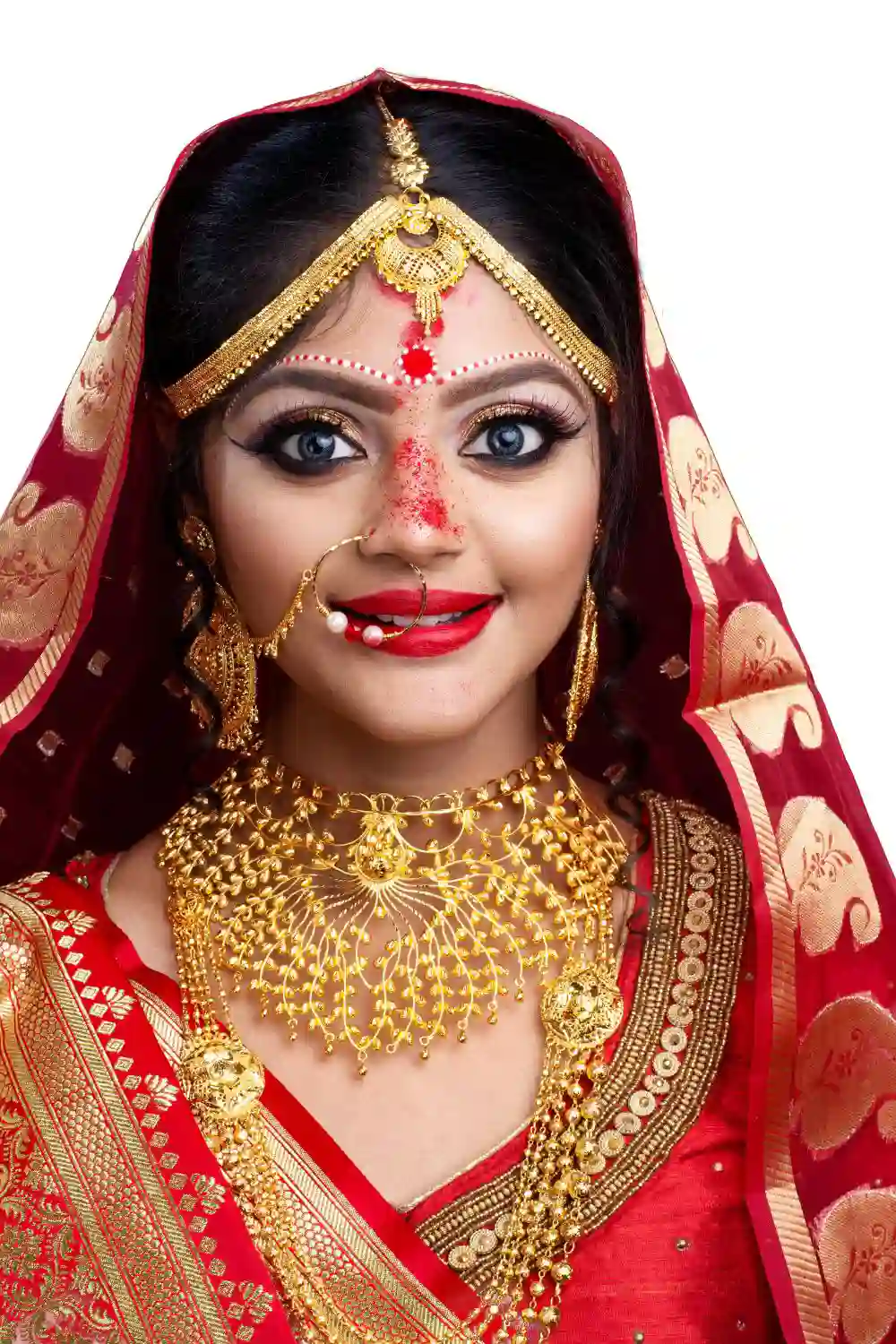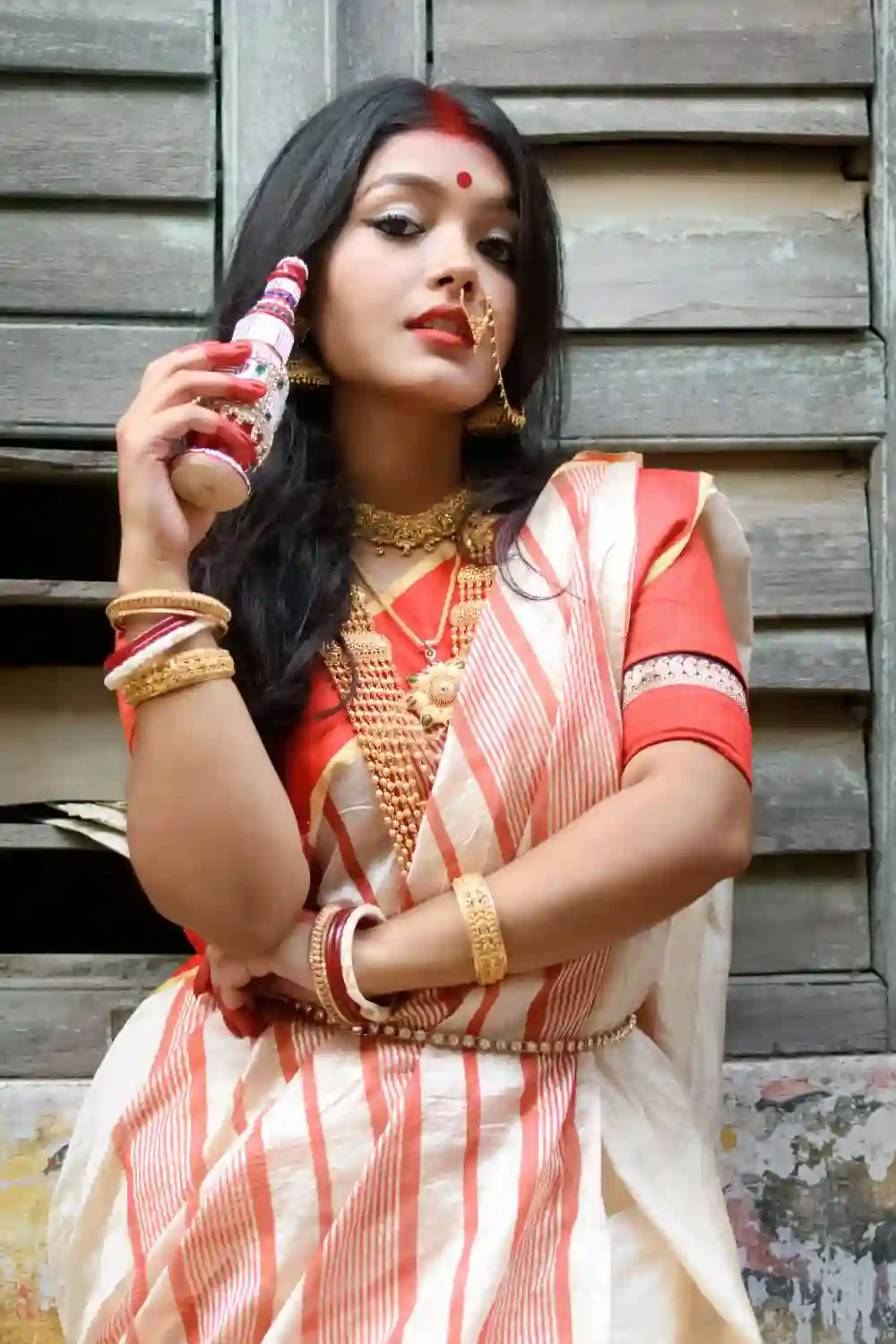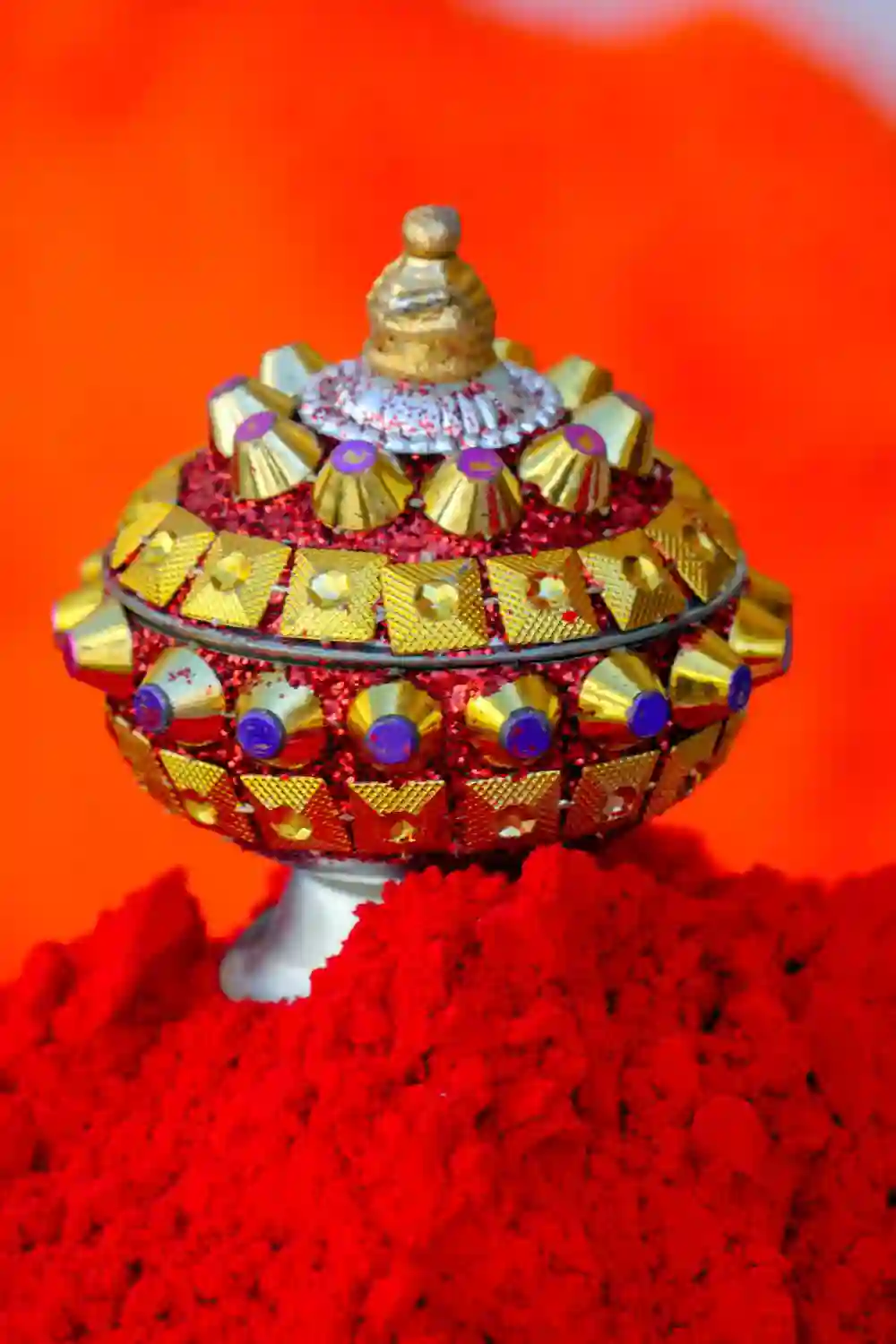Have you ever wondered why married Indian women sport a vibrant red mark on their hair? From ancient folklore to modern myths, the reasons behind this practice called sindoor intrigue many.
At its vibrant core lies sindoor, a mystical red powder made from the mineral vermilion. For generations, Hindu brides have adorned this sindoor, sparking curiosity about its significance.
Some say it symbolizes fertility and marital status. Others believe it wards off ill will. As per Hindu legends, the beloved goddess Parvati gifted this sindoor to devotees. So, does its alluring hue enhance allure or honor the wife-husband bond?
Unravel these sindoor secrets and myths behind its beguiling powers that have captured the Indian bride’s crown for centuries. A storied tradition or source of empowerment, what’s your take on this vermilion mystery?
What is Sindoor in Indian Culture?
Sindoor, sometimes referred to as vermilion powder, is a traditional part of Hindu wedding ceremonies in India. It is a bright red or orange-red colored powder that is usually made from turmeric or lime mixed with mercuric sulfide. Here are some important facts about sindoor in Indian culture:
- Sindoor is a traditional red powder made from turmeric and lime. It has a bright orange-red hue that stands out vividly against the skin.
- Women apply it in a vertical line, streak, or dot between the eyebrows and along the hair parting called the maang or mangalya.
- Sindoor comes in different consistencies, from dry powder to paste. Traditional homemade sindoor uses natural ingredients, while modern varieties may contain synthetic pigments.
- Other traditional names for sindoor include kumkum, Kasturi, and Kesar.

The History and Origins of Sindoor
Legend has it that sindoor traces its origins back to ancient Hindu scriptures. As per ancient texts like the Vedas and Puranas, sindoor symbolized a married woman’s love and commitment to her husband.
- The exact origins of sindoor are unknown, but it has been used for centuries in India, dating back over 5,000 years.
- Ancient texts like the Sanskrit epics Mahabharata and Ramayana mention sindoor, as do old literary works in various Indian languages.
- Historical evidence indicates sindoor was used irrespective of marital status. But around the 10th century CE, it became exclusively associated with married Hindu women.
- Some believe it originated as protection from evil spirits and the evil eye. Sindoor’s red color signifies power and strength.
- Others link it to fertility, passion, sensuality, blood, life energy, and marital bliss.
It is believed that in earlier times, married women would rub turmeric paste or haldi on their forehead and hair parting as a natural protection from sun damage. Gradually, this practice evolved into wearing sindoor.
The Cultural Significance of Sindoor for Hindu Women
For Hindu women, wearing sindoor is considered auspicious and sacred. It is an integral part of their identity as married individuals. The vibrant streak of red sindoor in the maang or parting of the hair indicates that a woman is married.
Not wearing sindoor would mean she is widowed or separated. So, sindoor plays a key role in how married Hindu women present themselves culturally.
The Different Types of Sindoor
There is no set recipe for sindoor. It comes in different varieties based on the region. Common sindoor types include mercuric sulfide sindoor, haldi sindoor, lac sindoor, and rubia cordifolia sindoor. Each variant lends the woman a distinguishing cultural identity.
What is the Significance of Sindoor in Hindu Religion?
Sindoor holds deep spiritual and religious symbolism in Hinduism:
- Sindoor signifies a married woman in Hindu culture. It represents her sacred bond with her husband.
- The red powder is thought to foster the longevity of marriages and enhance love between couples.
- Not wearing sindoor indicates a woman is widowed or separated. For married women, it is an essential part of bridal solah shringar (16 wedding adornments).
- Sindoor is prominently mentioned in Hindu scriptures as a pure, propitious substance:
- The Lalitha Sahasranamam venerates the Goddess’s sindoor tilaka or vermilion mark.
- Sindoor is said to please Lord Ganesha and invoke Lakshmi’s blessings.
- It is associated with Parvati, wife of Shiva. Sindoor is a symbol of the divine feminine Shakti energy.
- It is integral to married Hindu women’s solah shringar representing culture, identity, and values.
So, in essence, sindoor is the most visible manifestation of a Hindu married woman’s grihasta (householder) duties and her tie to religion. Its vibrant hue is reminiscent of divine marital bliss and celestial union.
Who Puts Sindoor on the Bride?
At traditional Hindu wedding ceremonies, the application of sindoor is a pivotal ritual:
- The groom, as the woman’s new pati or husband, is honored with placing the first vermilion line or bindi of sindoor in her maang.
- Then, her in-laws, especially the sasuraal waale or husband’s family who are now her own, ceremonially apply sindoor to finalize her married status.
This ritual signifies the bride now belongs to her new family and home. The groom and in-laws’ role underscores their acceptance and blessing of the woman into their household.
Why Do Indian Brides Wear Sindoor?
Indian brides wear sindoor for significant religious, social, and personal reasons:
- As an expression of their married state and newfound responsibilities as patnis.
- To honor age-old Hindu wedding traditions and mark their transition into a new identity and phase of life.
- Sindoor symbolizes their commitment to marital duties according to religious texts. Wearing it fulfills customary expectations and social mores.
- On an emotional level, it makes brides feel cherished, protected and enfolded in their new family as bahus after marriage.
So, in essence, sindoor is as much a religious observance as it is a cultural tradition for Hindu brides to showcase their married identity.
The Health Benefits of Wearing Sindoor
Intriguingly, sindoor provides certain natural health advantages too:
- Sindoor’s main ingredient kusumba or cinnabaris acts as a sunscreen, shielding the maang parting from harmful sun rays.
- It keeps the hair and scalp cool due to safranin pigment’s thermoregulatory properties that minimize excessive body heat.
So, in ancient times, sindoor served both symbolic and practical benefits for Hindu women working in hot, sunlit outdoors. Even today, its cooling, protective merits remain integral to a married woman’s well-being.
The Controversy Surrounding Sindoor
However, not everything about sindoor sparks joy. Certain aspects remain debated:
- Traditionalists defend sindoor as an auspicious tradition, while some feminists criticize it as another patriarchal custom subjugating women.
- Safety concerns loom over sindoor’s mercury content, which could possibly impair health, though research shows negligible risk in usual applications.
Does sindoor truly empower or rather subjugate? Only open yet nuanced discussion can provide equitable answers in changing times. At their heart, traditions must uphold no harm.
Sindoor in Popular Culture
Meanwhile, in entertainment, sindoor stirs both nostalgia and modern fascination:
- Bollywood movies glorified ideal Indian brides and their sindoor-adorned wedding splendor for generations.
- In Indian literature from ages past, sindoor described the bloom of young love and new Companionships.
- Artworks lavishly portray sindoor, highlighting women’s elegance across diverse regions and eras.
So, while contentious, sindoor retains its compelling allure and romance deeply woven into the subcontinent’s cultural fabric and social mores.

The Symbolism of Sindoor in Hindu Mythology
Ancient Hindu epics amplify sindoor’s meaning through mythological heroes:
- As per the Ramayana, Sita’s willingness to undergo an “agni pareeksha” (fire ordeal) won her Rama’s hand, so she always wore sindoor as a symbol of their eternal love.
- In the Bhagavata Purana, Radha’s love for Krishna grew each time she saw his reflection in her sindoor, emphasizing its role in divine passion and devotion between married couples.
These legends immortalize sindoor as love’s testimony bridging mortals and divinity while exemplifying how true relationships must withstand any test.
Different Regional Variations of Sindoor Application
Sindoor traditions also manifest in exciting localized diversity:
- North Indian customs like wider maang sindoor are traced to Persian bridal bindis.
- In southern states, sindoor mixes with kumkum, resulting in various hues and arc designs over the forehead and cheeks too.
Regional beliefs further weave the sindoor with legends. For instance, in Assam honors marriage as Bhagawan Brahma’s blessing according to the Bhagavata Purana.
This thriving regional lore attests to how Indian femininity blossoms in sindoor’s myriad cultural expressions across the spectrum of female experiences.
Modern Significance of Sindoor for Hindu Women
With changing times, sindoor’s relevance for Hindu women is perceived differently, too:
- Today, views on sindoor are changing with women’s evolving social roles.
- Some progressive women see it as a patriarchal symbol and reject it. Others view it as empowering and proudly embrace the tradition.
- Hindu feminists aim to redefine traditions like sindoor by highlighting gender equality and women’s autonomy.
- Intercaste and interfaith marriages are relooking at wedding rituals, including sindoor. Modern brides apply it in creative new styles.
- Debates continue on whether sindoor oppresses or empowers women. But many believe women should have the freedom to choose what a tradition means to them.
- Younger brides value both tradition and individuality, so experiment with delicate sindoor styles balanced with other jewelry.
- It sparks nostalgia for diaspora communities distant from familiar customs yet desiring cultural continuity.
- Sindoor let outsider weddings incorporate Indian touches, respecting diverse beliefs yet fostering a sense of shared heritage.
So while traditions morph, sindoor endures – a proud badge both treasured yet liberating in its versatility, synchronicity of past and present joyously blended.
The Future of Sindoor in Indian Culture
It seems sindoor will remain significant for generations to come:
- Younger Hindu brides find new, meaningful ways to define femininity, aligning with traditional and modern aspirations.
- Digital media ensures Sindoor’s living history and diverse stories touching all ages worldwide, multiplying its relevance.
- Academia highlights sindoor’s holistic development, portraying complex identity negotiations sensitively.
Indeed, sindoor’s journey through the ages reassures us that even as mores change, certain symbols emphasizing life’s sacred bonds and our shared spirituality may well endure forever.

Summary
Sindoor’s timeless legacy stands the test of changing societal tides. Its symbolic power lies not in rigid tradition but in nuanced meaning to each woman. While views evolve on feminine empowerment, at sindoor’s core, they remain tied to two souls in devotion’s dye.
Daughter, daughter-in-law, wife, or mother – its versatility transcends labels. Whether an auspicious ritual, remembrance of those lost, or a vibrant reminder of the loved one, sindoor is life’s profound mysteries simply woven in a thread.
For some, it liberates; for others, it anchors, but all find belonging in its loving embrace. As the past meets the future on today’s canvas, perhaps solutions lie not in “or” but inclusive “and”.
For though customs morph, love, protection, and celebration of relationships accord sindoor a sanctified place, nourishing shared heritage through unique expressions of individuality. Such reconciliations ensure Sindoor, as a woman, forever blossoms.
FAQ
Do Muslims have sindoor?
It is not a religious requirement in Islam for Muslim women to wear sindoor. Islamic practices and traditions vary across different regions and cultures, and wearing sindoor is not a common practice among Muslim women. While there may be some instances where Muslim women choose to wear sindoor for cultural or personal reasons, it is not a widespread practice within the Islamic faith.
Does Saraswati wear sindoor?
Yes, according to Hindu mythology and traditions, Goddess Saraswati is often depicted wearing sindoor. Sindoor is considered a symbol of auspiciousness and is associated with married women in Hindu culture. The red vermillion powder is applied on the parting of the hair and sometimes on the forehead.
Is it lucky if sindoor falls on the nose?
According to Hindu beliefs and superstitions, it is considered lucky if sindoor falls on the nose of a married woman. This belief suggests that when sindoor accidentally falls on a woman’s nose, it signifies her husband’s love and affection. It is believed to bring good luck and happiness to the marriage.
Which Colour sindoor is best?
Traditionally, the most commonly used colors for sindoor are maroon, blood red, and orange-red. Maroon sindoor is a popular choice and is often considered classic and elegant. Orange-red sindoor is also considered auspicious and is believed to bring good luck.
Which finger do you use for sindoor?
In Hindu culture, the sindoor is traditionally applied on the parting of the hair or the forehead using the ring finger of the dominant hand (usually the right hand for most people). The ring finger is believed to be connected to the heart and is considered auspicious for applying sindoor. However, it’s essential to note that the specific finger used for applying sindoor can vary among different traditions and personal preferences. Some may use the middle finger or even the thumb.



